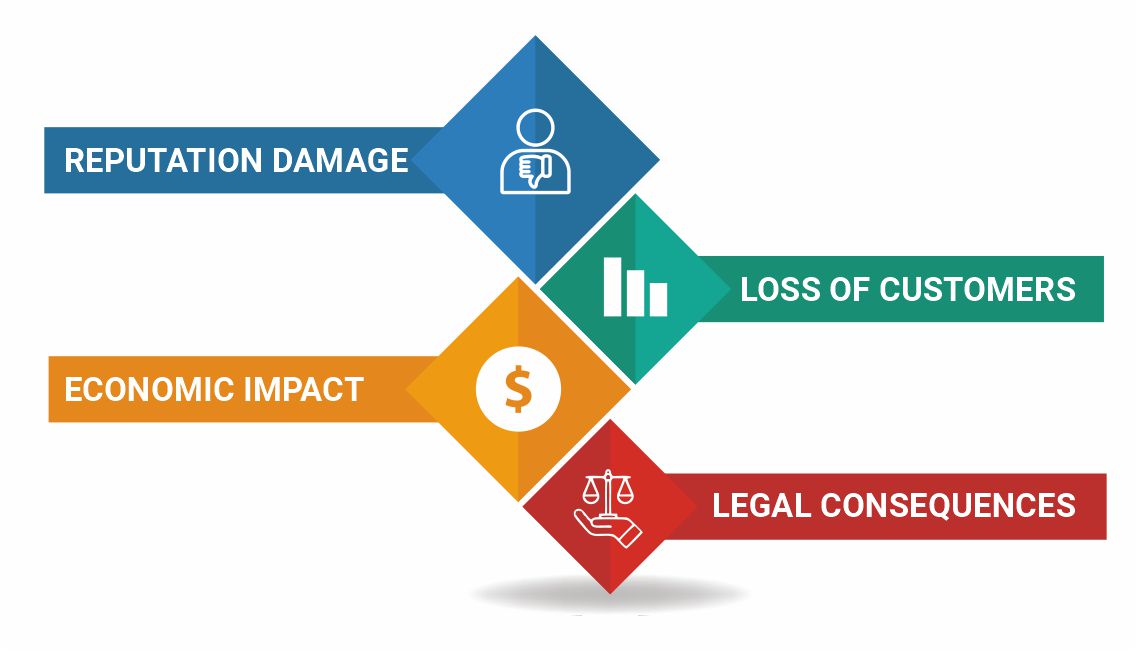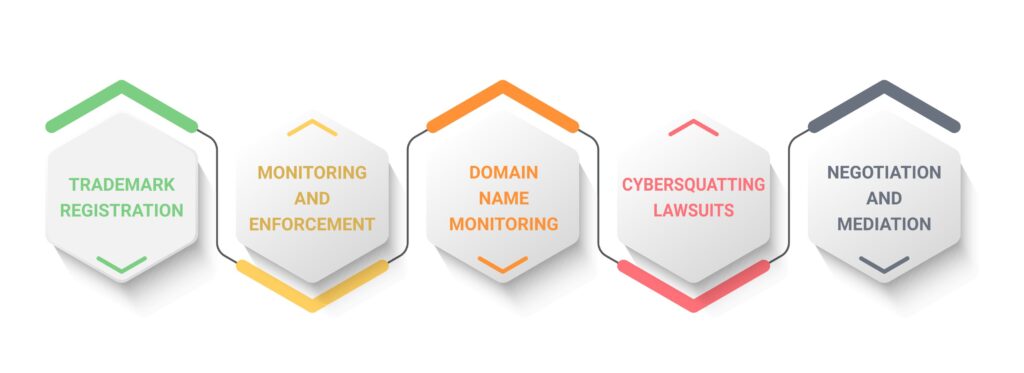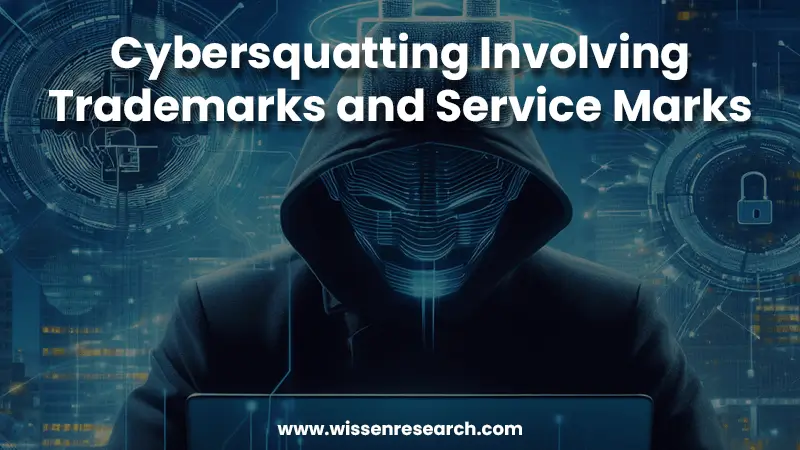In today’s digital age, where the internet has become an integral part of our daily lives, maintaining a strong online presence is crucial for businesses. However, with this increased online activity, a new form of intellectual property infringement has emerged “cybersquatting“.
Cybersquatting involves the unauthorized registration, use, or trafficking of domain names that closely resemble or infringe upon trademarks and service marks, posing a significant threat to brand owners. This article delves into the world of cybersquatting, its implications, and strategies for brand protection.
Cybersquatting: Cybersquatting, also known as domain squatting, refers to the practice of registering, trafficking, or using domain names that are confusingly similar to established trademarks or service marks with the intent of profiting from the goodwill and reputation of those marks. The cybersquatter typically seeks to sell the domain name to the rightful owner at an inflated price or uses it to divert web traffic for financial gain or malicious purposes.
Types of cybersquatting
- Typosquatting: Typosquatting, also known as URL hijacking, involves registering domain names with slight misspellings or typos of popular websites. For instance, instead of “facebook.com,” a typosquatter might register “facbook.com.” The purpose of typosquatting is to catch users who make typographical errors when entering a website’s URL. These malicious sites can then be used for various purposes, including distributing malware, phishing, or displaying deceptive content.
- Trademark Cybersquatting: Trademark cybersquatting targets well-known brand names and trademarks. Cybercriminals register domain names containing the trademarked terms with the aim of selling the domain to the legitimate trademark owner for a substantial profit. This type of cybersquatting is often intended to exploit the brand’s reputation and potentially tarnish it by hosting counterfeit goods or misleading content.
- Generic Cybersquatting: Generic cybersquatting focuses on registering generic or common terms as domain names, which could potentially become valuable in the future. These domain names are often registered with the hope of selling them to businesses looking for relevant domain names or gaining traffic through advertising. Examples of generic cybersquatting include domains like “business.com” or “insurance.com.”
- Geographical Cybersquatting: Geographical cybersquatting targets location-specific domain names and is often associated with cybercriminals attempting to profit from regional brands, cities, or countries. For instance, a cybersquatter might register a domain like “parisvacation.com” and attempt to profit by selling it to a legitimate business in the tourism industry looking to attract visitors to Paris.
- Reverse Cybersquatting: Reverse cybersquatting occurs when a trademark holder attempts to acquire a domain name from its rightful owner through legal or other pressure, claiming that the domain name infringes on their trademark. This can be a contentious issue, as some trademark holders may abuse this tactic to seize domains from legitimate owners who were unaware of the trademark.
- New gTLD Cybersquatting: With the introduction of new generic top-level domains (gTLDs), such as .app, .blog, and .guru, cybersquatters have expanded their opportunities. They register domain names with these new gTLDs that resemble popular or trademarked terms, hoping to take advantage of user confusion or resell the domains at a profit.
- Non-Commercial Cybersquatting: Not all cybersquatting is motivated by profit. Some individuals may register domain names with no intention of financial gain but rather to tarnish a brand or person’s reputation, engage in political activism, or promote a particular agenda. Non-commercial cybersquatting can still cause significant harm to the target.
Implications of Cybersquatting

- Reputation Damage: Cybersquatting can damage a brand’s reputation when unsuspecting consumers stumble upon websites that mimic the genuine brand but offer counterfeit or misleading information.
- Loss of Customers: Unauthorized domain usage can divert legitimate web traffic away from the brand’s official website, leading to a loss of potential customers and revenue.
- Economic Impact: Brands may need to spend considerable resources on legal actions to regain their domain names, which can be both financially and time-consuming.
- Legal Consequences: Cybersquatting is illegal in many jurisdictions, and brand owners can take legal action against cybersquatters to protect their rights. Penalties may include fines and the transfer of the domain name to the rightful owner.
Protecting Against Cybersquatting

- Trademark Registration: Registering your trademarks and service marks with relevant intellectual property offices is a foundational step in preventing cybersquatting. This legally establishes your ownership and can be used as evidence in legal actions against cybersquatters.
- Monitoring and Enforcement: Actively monitor domain registrations and online platforms for potential infringements. Utilize online brand protection tools and services to detect suspicious domain registrations.
- Domain Name Monitoring: Regularly check domain name registrations that resemble your brand and take action as soon as you detect potential cybersquatting. Legal action, such as the Uniform Domain-Name Dispute-Resolution Policy (UDRP) or the Anticybersquatting Consumer Protection Act (ACPA) in the United States, can help recover domain names.
- Cybersquatting Lawsuits: If you discover that a domain name has been registered in bad faith and is infringing upon your trademarks or service marks, consider taking legal action against the cybersquatter. Legal remedies may include damages, injunctions, and the transfer of the domain name.
- Negotiation and Mediation: In some cases, negotiation or mediation with the cybersquatter may be a quicker and more cost-effective solution. Cybersquatters often prefer settling disputes to avoid legal trouble.
Suing Under the Anticybersquatting Consumer Protection Act
The Anticybersquatting Consumer Protection Act (ACPA) is a powerful legal tool designed to protect trademark owners and consumers from unscrupulous individuals who register and use domain names in bad faith. Since its enactment in 1999, the ACPA has played a crucial role in combating cybersquatting and safeguarding the integrity of the internet
The ACPA’s Objectives
The ACPA’s primary objective is to protect trademark owners and consumers from the deceptive and harmful practices of cybersquatters. It aims to:
- Prevent domain name registrants from profiting from the bad-faith use of trademarks.
- Protect the goodwill and reputation of trademark owners.
- Ensure clarity and transparency in the online marketplace, reducing consumer confusion.
Key Provisions of the ACPA
i. Bad Faith Intent: To successfully bring a claim under the ACPA, a plaintiff must demonstrate that the defendant registered, used, or trafficked the domain name in bad faith. Bad faith includes circumstances where the registrant intended to profit from the mark’s reputation or divert traffic from the trademark owner’s website.
ii. Identical or Confusingly Similar: The ACPA requires that the domain name be identical or confusingly similar to the plaintiff’s trademark. This similarity is a critical element in establishing a violation of the act.
iii. Proving Damages: A successful ACPA claim can lead to various remedies, including injunctive relief, damages, and forfeiture of the infringing domain name. The plaintiff must demonstrate actual damages or that the defendant’s bad faith was intentional.
Suing Under the ACPA
Bringing a lawsuit under the ACPA involves several key steps:
- Identify the Cybersquatter: The first step is to identify the individual or entity behind the infringing domain name. This may involve conducting research to uncover their identity and contact information.
- Consult Legal Counsel: It is crucial to consult with an experienced intellectual property attorney who can assess the strength of your case and guide you through the legal process.
- Draft a Complaint: Your attorney will help you draft a complaint outlining the specific details of the infringement, demonstrating bad faith, and providing evidence of potential harm to your trademark.
- File the Lawsuit: Once the complaint is ready, your attorney will file the lawsuit in federal court. A successful ACPA lawsuit can result in the transfer of the infringing domain name to the trademark owner, damages, and injunctive relief to prevent further infringement.
- Litigation Process: The litigation process involves various stages, including discovery, motion practice, and trial, if necessary. Your attorney will work to build a strong case and negotiate with the defendant to resolve the dispute.
Cybersquatting is a growing concern for businesses in the digital era. Protecting your trademarks and service marks from cybersquatters is not only essential for maintaining brand integrity but also for safeguarding your financial interests. By staying vigilant, monitoring online activity, and taking proactive legal steps, brand owners can successfully combat cybersquatting and secure their digital brand identities. In a world where the online presence of a business is often its first point of contact with customers, defending against cybersquatting is a vital part of brand protection and corporate strategy.
Authored by – Nitesh Chouhan
Edited by : Guniyal




